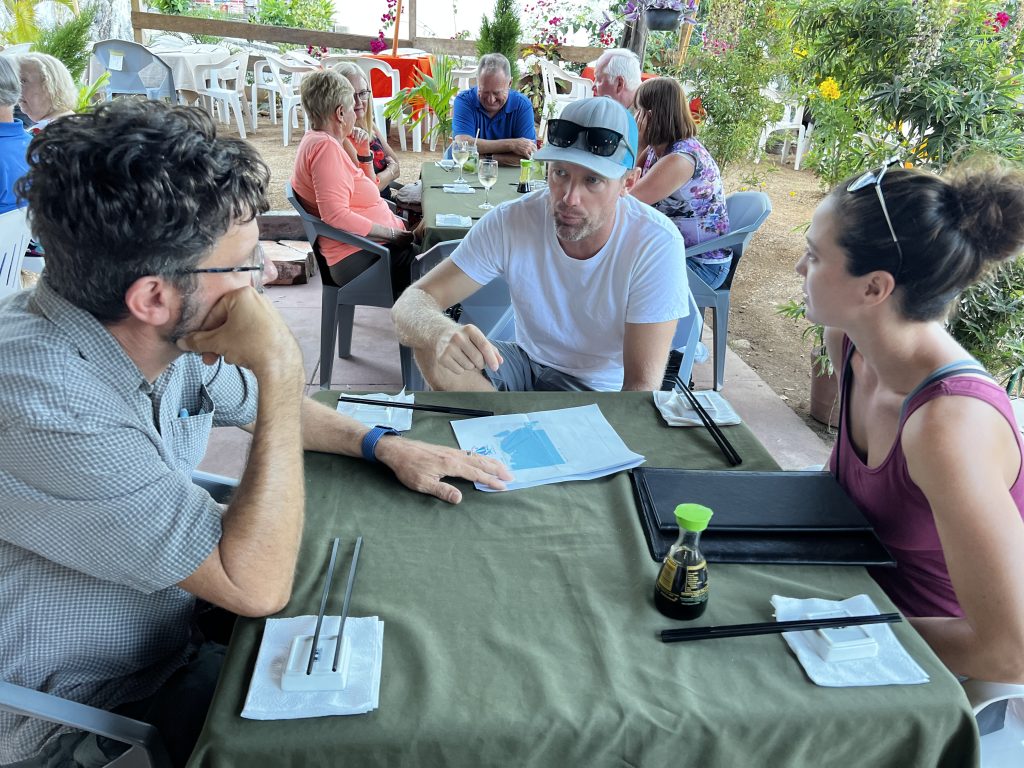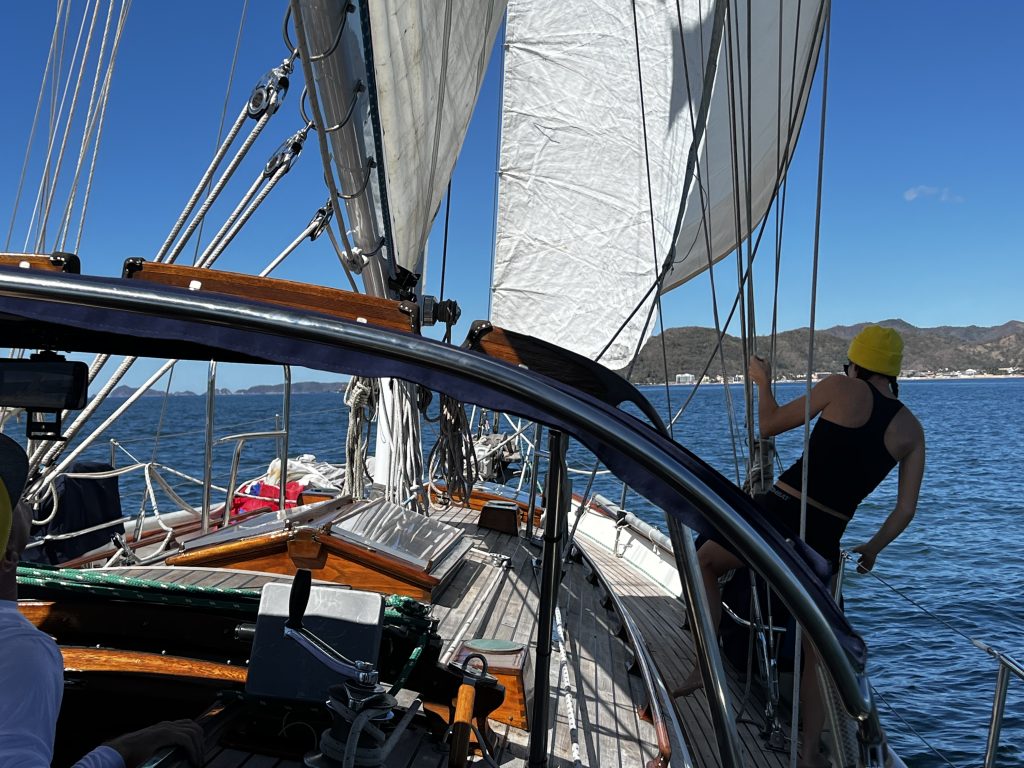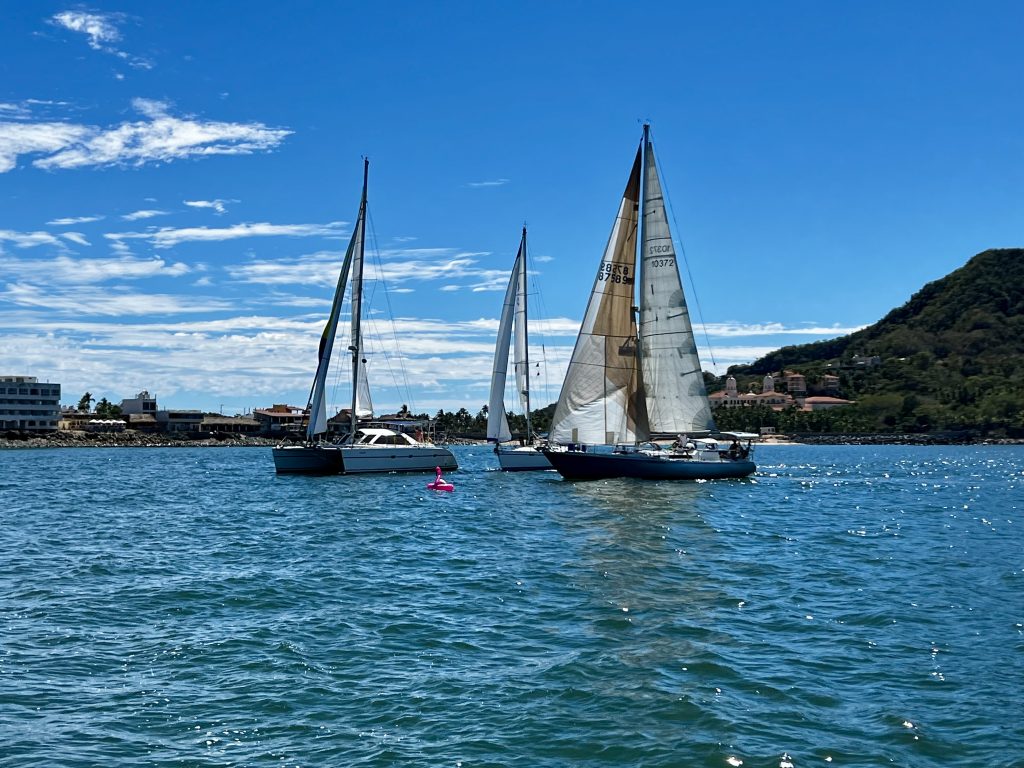Racing Our House – Part 1
Friday February 11 – Race Day in the Barra de Navidad Cruise In Week.
This race caps of a week of fundraising for the schools in Barra de Navidad and the race is used as a way to drum up donation which people can use to place ‘bets’ on boats to win a chance at a raffle prize. At the end of the race all of the ‘bets’ for the winning boat are put into a hat to draw for raffle prizes. The race course follows the beach from Barra de Navidad to Melaque where spectators in the beachfront bars can watch the race and place more ‘bets’ up until the first boat makes the first mark (or something like that). The idea is to encourage more donations by letting spectators continue to bet as the race plays out.
Leading up to race day we had prepared Sonrisa to put on her best race possible. We hired a local diver at the marina to scrub all of the algae and barnacles off her bottom and gave the topsides a good fresh-water wash to boot. We enlisted our friends Wes and Susan on Sauce Sea to crew for us and even went out on an afternoon sail to do a couple of practice laps on the course the day before the race. We cleared the decks of any unnecessary gear and stowed the windvane components. The morning of the race we removed the dodger windshield and bimini connector to further reduce our wind resistance. With the exception of the solar panels on the stern arch by race day Sonrisa was looking unusually sleek.
Recognizing that the participating boats are ‘cruisers’ and of varying sizes, a handicapping mechanism is used to theoretically make all boats competitive by letting the slower boats start first and the faster boats start last. The time difference is based on a calculated potential speed of each boat based on its design. Since the handicap is built into the start time, the first boat across the finish line wins. This is known as a “Pursuit” race.
The day before the big race I went to the mandatory skippers meeting outside the marina office where the course was described and the start times were assigned. The race organizer was describing how the pursuit start works as he handed out a paper with start times for each boat listed. I expected to see Sonrisa start fairly early, probably shortly after last years winner Dulce, a Cape Dory 34 but before Due West, a Passport 40. As he handed me my copy of the start times he announced, “With a VYC rating of 195, Sonrisa will be first to start the race.”
“Woo hoo!” I exclaimed with a hint of irony.
“You know what that means, don’t you? We think you have the slowest boat,” he said with a chuckle.
“I’ll take it!” I again exclaimed a bit too enthusiastically.
At the meeting we also learned that there was a slight change to the course from last year. The race would start a bit offshore and the first mark would be off the beach at Barra making for a short dead-downwind leg to start. This was going to be very tricky as the wind at that end of the course is light at that time of day and dead-downwind isn’t a good point of sail for us. That night over a plate of sushi, ribs and wings, we discussed possible strategies with our crew.

Race day came and by mid-morning the crew was well-stuffed with French Baker croissants and by late morning we headed out into the bay to prepare. We discussed start strategies and how to deal with the dead-downwind start. We hoisted the mainsail and motorsailed around the starting area to check out the position of the starting committee boat (the start line) and the first mark and think about strategy. At first I thought perhaps we should run in at an angle to the wind which would be better for boat speed, but that would take us in towards the beach where there’s even less wind and we’d have to then gybe to get back to the first mark. As the minutes ticked by toward start time I looked at the ripples on the water, saggy sails and general lack of wind. Any minute the wind would pick up as is usually does in the afternoon, but the question was when. If we were all stuck at the start line together, then our handicap disappears and we are all effectively starting when there’s enough wind to start moving. Hmm. This could be bad.
“At the skipper’s meeting they mentioned that we were allowed to use our engines until one minute before our start time,” I said forming our plan out loud.
I say we use that to get ourselves lined up on our course and moving in the right direction further out and we shut off the engine exactly one minute before our start and try to drift across the start line dead downwind toward the first mark and just cross our fingers that we can ghost our way directly to the mark. It will take too much time to try to deal with the spinnaker and once we’re to the mark we’ll be on a reach and should start moving again.”
“Rules are tools!” Wes shouted agreeably.
“Ok, we still have some time and we’re first to start so we don’t need to stay clear of the starting area yet. Let’s practice a few starts.”
After a couple of practice starts I felt we had the distance to the start line bracketed. 12:00 was quickly approaching and it was time to get into position. I was on the helm, Kristin had her finger on the engine Stop button with an eye on the clock, and Wes and Susan were on the sail trim.
“Ok, countdown, here we go,” as I turned Sonrisa toward the mark. Wes worked the headsail sheets as Susan ran forward to hold the boom in the light air. Kristin watched the clock countdown to one minute to our start.
“One minute!” Kristin shouted as she stopped the engine.
Sonrisa was immediately quiet with just a sound of a gentle ripple of water off her stern. We all watched with anticipation as Sonrisa drifted toward the starting pin.
With just a few yards to go we heard the starting horn and Kristin yelled “Start!”
We did it! A nearly perfect start. We celebrated for a moment then nervously watched as Sonrisa drifted toward the first mark. It was hard to tell if we were even moving but looking back we could see that no one else was doing any better.
“Dulce started!” Susan shouted, looking back off our stern.
I looked back and saw that Dulce, last year’s winner, had her spinnaker up for the start. I worried if our strategy would work this time to forgo the spinnaker for the first mark.
I kept the bow pointed directly at the first mark as we lazily drifted toward it. Every few minutes I’d check over my shoulder to see if Dulce was catching us with her spinnaker.
“She’s having to go up to keep the spinnaker full!” Wes shouted.
Sure enough we saw that Dulce was taking the track we rejected, angling further in toward the beach to try to keep the spinnaker full, but being drawn further into the wind shadow of the bay.
What seemed like an eternity later, we reached the first mark and turned to run parallel to the beach toward Melaque. Wes and Susan instinctively trimmed up the sails for a beam reach and a few moments later I could hear the gurgle from the stern get louder. We were moving!
As we got further from the beach Sonrisa found her groove flying all three sails in the light winds, Wes and Susan constantly trimmed the sails, watching the tell tales for any shifts.
The VHF radio which was tuned to the race channel crackled to life, “Go, Sonrisa go!” I recognized the voice as Tony’s on Dulce. I looked back to see that we were half-way down the first leg and the entire rest of the race fleet was stuck along with Dulce trying to get around the first mark. It truly looked like bumper-boats back there.

Meanwhile, as I would learn later, the mayor of Barra de Navidad was in one of the bars on the beach watching the race. She had placed her bets on Sonrisa and was reported to be very excited to see us pulling away in the lead and was cheering us on too!
We stayed with our white sails as we reached toward Melaque. As we had practiced we steered a course a little further out into the bay to get better wind, expecting that there would be a shift at the Melaque end that would help us around the mark. As we approached Melaque I started scanning the beach for the marker. All of the markers for this race were large inflatable flamingo pool-toys. While large in a pool, they are much smaller than typical race marks and we weren’t yet seeing the mark.
“It will probably be really close to the beach over by the hotels,” I shouted as everyone scanned the horizon for the pink flamingo. “They want to draw us in so the spectators can see.”
“I’m not seeing it!” Susan shouted back.
“I think that’s it over there! To the right of the yellow panga!” Kristin shouted.
I scanned the horizon with the binoculars.
“Yes, I think that’s it!” I confirmed.

The wind was a bit stronger now and Sonrisa was making good way toward the mark. I angled Sonrisa toward the marker and looked back to see how we were holding up. I could see that the fast boats had broken free from the cluster at the first mark and were charging up close to the beach flying their reaching spinnakers.
Sonrisa was first to the mark and rounded to start the third leg back toward Barra. We again had a momentary celebration onboard as we rounded the mark.
But I could see that the fast boats had effectively used their spinnakers reaching up the beach and made up a lot of ground fast. White Raven and Gladiator were battling their way up to the mark as we started our reach back toward Barra. Last year this was the leg that Dulce won running her spinnaker and while the wind angle was a bit different than last year I figured if we could get the spinnaker up we could keep it up in the 7-10 knot breeze.
“What do you think, should we try the spinnaker?” I asked Wes.
“Your call but don’t know if we have enough wind angle.” Wes replied.
“I think it will be more reach-y once we’re further out from Melaque. We may need to fall off to get it set then harden up on it.” In my mind I was replaying last year’s race that we could have won if we had managed to launch the spinnaker, taking a ‘safe’ second instead. I glanced over my shoulder to see White Raven and Gladiator, both larger boats (Cavalier 45, Beneteau 461), rounding the mark. Our lead wouldn’t hold much longer if we didn’t try something.
“Let’s do it!” I said as I turned the helm over to Kristin and we took our assigned positions.
Setting the spinnaker first requires us to roll-up our head sail and drop the staysail to get them out of they way and allow for undisturbed wind to fill the spinnaker as we “un-sock” it by raising the “socked” spinnaker up the mast, then hoisting the sock up off the sail to reveal the voluminous sail. So for a few critical minutes Sonrisa is slowing while sails go up and down, so the quicker we can change the better. This was the one thing we couldn’t practice earlier in the week as it was later in the afternoon and we felt the winds were too strong.
“Ok ready?” I called back to Kristin at the helm and Wes on the spinnaker sheet.
“Ready!” they called back.
“Hoisting!” I yelled as I yanked on the spinnaker sock line. The bright red foot of the sail started to flutter in the wind as the sock slid up the sail. Once it was only about a quarter of the way up I could feel resistance in the sock line as the sail got balled up inside the sock.
“It’s stuck! I’m going to try it again!” I yelled as I pulled the sock back down to ease the pressure then pull it back up. It got to the same place and once again stopped hard. I tried the line back and forth several times. In the corner of my eye I saw White Raven pass us followed closely by Gladiator.
“Forget it, it’s not coming out!” I yelled. “Get the yankee back out!”
I dropped the socked spinnaker as Susan furiously gathered it on deck and tied it down. Wes pulled the yankee back out as I reset the staysail.
“That’s the race.” Wes said what we were all thinking.
We trimmed the sails and once again were making good speed to finish the first lap. We weren’t catching White Raven or Gladiator, but we were doing our best to hold our own and still managed to maintain third as we rounded the mark to start the second lap.

We managed to hold the rest of the fleet off as we started the second lap, but approaching the Melaque mark we could see our friends on Carmanah (C&C 43) steadily catching us along with Hey Ya (Beneteau 390) and Catitude (Lagoon 42) close behind.
In the end we finished sixth out of sixteen, but if we hadn’t messed with the spinnaker on the third leg we would have had a chance for fourth. Not bad at all for the “slowest boat” in impossibly light air with only white sails. But more importantly with the exception of the spinnaker failure we felt we sailed really well and had a lot of fun for a good cause.
After the race, we received many compliments from the actual racers in the race how well we sailed and how “freakishly fast” Sonrisa is for her size and displacement. Really, when I stopped to think about it, we outperformed all of the other moderate to heavy cruisers in the race and the only boats that caught us were lighter, larger, performance boats, some with functioning spinnakers, all of which have a significant advantage in light winds like we had that day.

